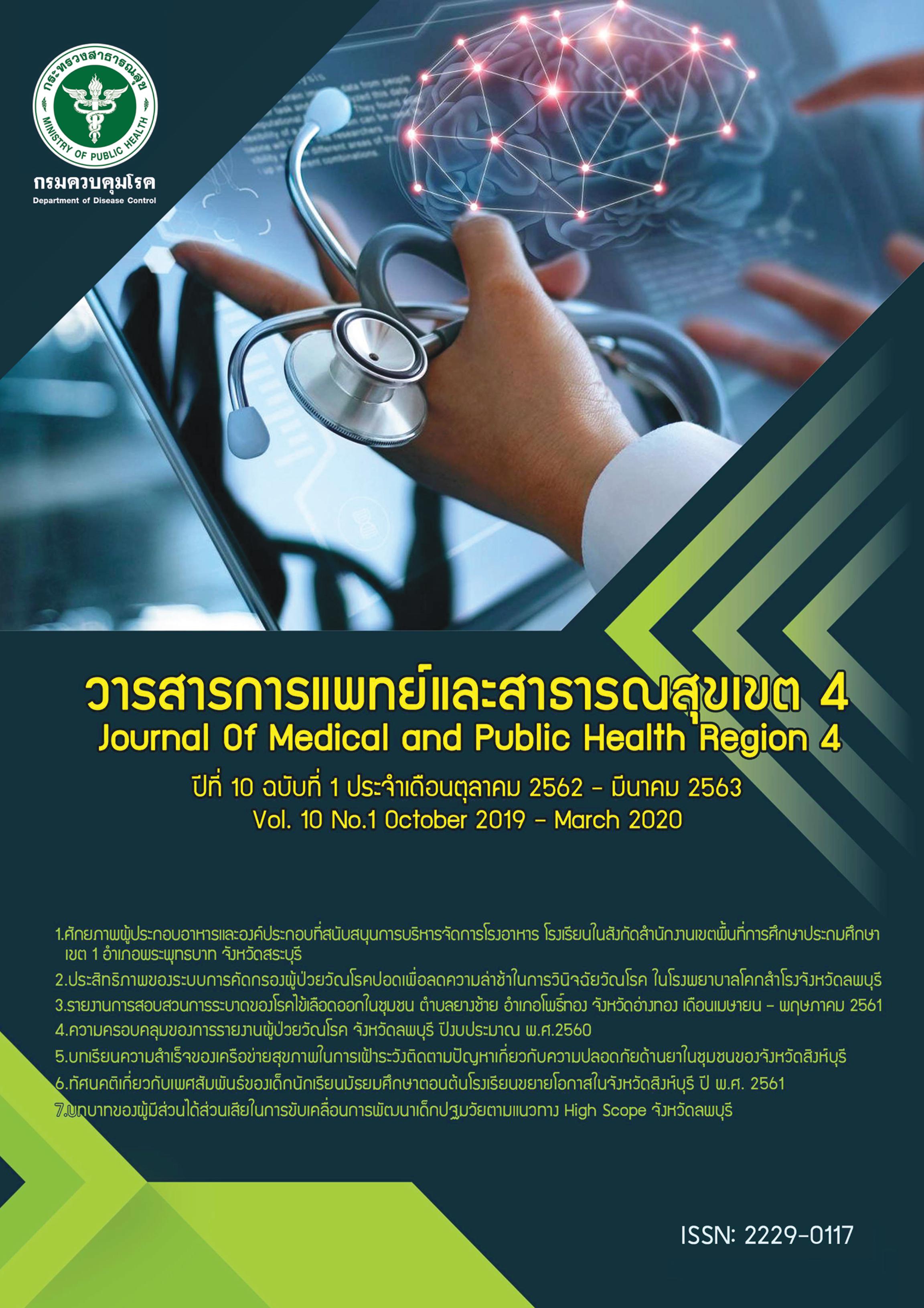Sexual Attitudes among Students of Secondary Level 1-3 in Educational Opportunity Expansion Schools in Singburi Province, 2018
Main Article Content
Abstract
Currently, knowledge, attitudes and skills related to sexual life among young people are low, making them vulnerable to exploitation and sexual abuse resulting in unwanted pregnancy and sexually transmitted infections, including HIV. The objective of this study was to assess attitudes about sex among students of secondary level 1-3 in educational opportunity expansion schools in Sing Buri Province. This questionnaire-based survey was conducted in 45 schools with a sample size of 1,863 students in 2017-2018. After the survey, students participated in Life Skills Program to prevent HIV. Data included students’ characteristics and sexual attitudes. Overall 25.4% of the students had high risk to have sex during their schooling period. Boys (30.4%) were more likely to have high risk than girls (19.4%). Of the survey students, 34.0% thought that having sex could be acceptable as a part of love; 15.2% thought that they could not refuse sex with their girlfriend/boyfriend; while 22.3% were not aware and could be exploited when they were in private or isolated spaces. Since students remain to have high risk of having sex during schooling and lack of skills to refuse sexual pressures with their boyfriends/girlfriends, it is essential to empower these students to make considered decisions on abstinence and relevant safe sex practices to prevent pregnancies and HIV infection.
Article Details
References
2. Haffner DW. Facing facts: sexual health for American us adolescents. J Adolesc Health 1999; 22:453-9.
3. Ruangkanchanasetr S, Plitponkarnpim A, Hetrakul P, Konsakon R. Youth risk behavior survey: Bangkok, Thailand. J Adolesc Health 2005; 36:227-35.
4. ศรีศักดิ์ จามรมาร. ความคิดและพฤติกรรมทางเพศของวัยรุ่น: กรณีศึกษาเปรียบเทียบในมุมมองของวัยรุ่นที่อยู่ในระบบสายการศึกษาสายสามัญ(มัธยมปลาย)และสายอาชีพ(ปวช.). สำนักวิจัยเอแบคโพลล์ มหาวิทยาลัยอัสสัมชัญร่วมกับคณะแพทย์ศาสตร์ โรงพยาบาลรามาธิบดี ในความสนับสนุนของสำนักงานกองทุนสนับสนุนการสร้างเสริมสุขภาพ(สสส.) 30 ม.ค.- 6 ก.พ. 2547.
5. Meschke LL, Bartholomae S, Zentall SR. Adolescent sexuality and parent-adolescent processes: promoting healthy teen choices. J Adolesc Health 2002; 31(Suppl 6):264-79.
6. Agha S, Van Rossem R. Impact of a school-based peer sexual health intervention on normative beliefs, risk perceptions, and sexual behavior of Zambian adolescents. J Adolesc Health 2004; 34:441-52.
7. อุษาสินี ริ้วทอง. สาระสารพัน : บทความจาก teenpath. กรุงเทพฯ : องค์การแพท, 16 มกราคม 2552. ค้นหาและพิสูจน์ “สูตรการทำงานจากเอดส์...สู่เพศศึกษา”: สำเร็จหรือไม่...ต้องลงมือทำ !.[ออนไลน์]. เข้าถึงได้จาก : http://www.teenpath.net/content.asp?ID=729 สืบค้น 15 สิงหาคม 2561.
8. Manaboriboon B, Sujritpongsa S, Chomchai C, and Pornjamsai S. Sexual attitudes of adolescent girls after an interactive seminar on sexuality. Siriraj Med J 2006; 58: 654-657.
9. Agha S. An Evaluation of the effectiveness of a peer sexual health intervention among secondary-school students in Zambia. AIDS Educ Prev 2002; 14: 269-81.
10. Talashek ML, Norr KF, Dancy BL. Building teen power for sexual health. J Transcult Nurs 2003; 14: 207-16.
11. UNESCO. แนวทางเชิงวิชาการสากลของเพศวิถีศึกษา การใช้ข้อมูลเชิงหลักฐานสำหรับโรงเรียน ครู และผู้ให้ความรู้ด้านสุขภาพ. เล่มที่ 1 หลักการและเหตุผลของเพศวิถีศึกษา. แปลโดย Somjai Pramanpol. UNESCO Bangkok 2012; iii.
12. Silayan-go A. Youth to youth intervention. Integration 1998; 55: 26-7.
13. La Torre G, De Vito E, Martellucci L, Langiano E, Ricciardi G. Knowledge, attitudes, and practices regarding sexually transmitted diseases among students in 3 high in Cassino. Ann Ig 2002; 14: 233-42.
14. Rudrauff A. Student –centered sex education. Human development and family life bulletin. A review of research and practice 1999;4:4.


